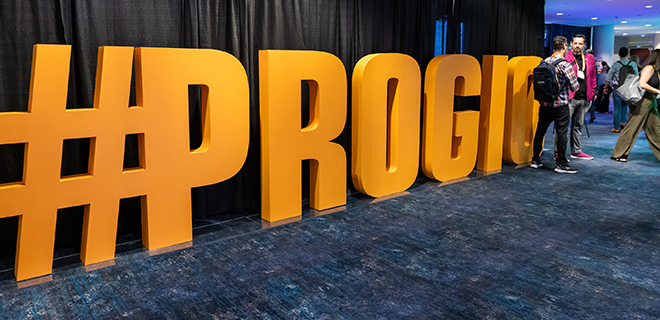
Publishers and marketers are at a crossroads where technology and creativity must converge to unlock the ecosystem’s potential. On Day 1 of AdExchanger’s Programmatic IO, industry leaders highlighted how balancing innovation and content creation can shift the future for the better.
Technology is evolving faster than we can blink and it’s becoming clear that it’s time creativity and control were reclaimed. As monopolies and walled gardens dominate and limit access, the balance between innovation and content creation is more crucial than ever. In a rapidly changing ecosystem, publishers are exploring strategies to navigate an open internet increasingly challenged by distribution obstacles and signal loss.
Once a beacon of free and open access, the open web faces an identity crisis. Media companies that once thrived on direct consumer connection are struggling with the rise of walled gardens. Marketers, for their part, acknowledge their role in building these silos as they increasingly funnel media budgets into tech giants. Reclaiming control of data, creative strategies, and audience engagement is critical to preserving the future for both sides.
Publishers should not look at these shifts as threats but as opportunities to develop new strategies that align with consumer behavior and market demands.
From the rise of social-driven search and FAST channels to Google’s ongoing antitrust trial, ProgIO spoke to many of the challenges facing publishers today. As the industry continues to push for transparency, fairness, and a more open ecosystem, the path forward depends on innovating while maintaining trust with consumers and each other.
Here are our top takeaways from Day 1.
Breaking Free: How Marketers Can Reclaim Creativity in a Tech-Driven World

Eoin Townsend, Chief Product Officer at Cadent, talking about convergence at programmatic IO. Photo by Donna Alberico.
Eoin Townsend, Chief Product Officer at Cadent, walked us through industry shifts driven by audience, inventory, optimality, and privacy. He says, “The technology we have today is not the technology we’ll have tomorrow.”
Let him tell it: marketers need more control to move away from monopolies and hone in on new technologies to transform their roles in the industry. Eoin emphasized that marketers spend too much time on tech rather than creative marketing. We are evolving from scale, automation, and walled gardens to a new phase focused on integration, alignment, and collaboration.
More highlights from his talk:
- Let AI automate the hard stuff.
- Take advantage of multi-faceted solutions that integrate third-party data and work across walled gardens.
- Adopt new technology and legal frameworks to ensure compliance and consumer trust.
Eoin’s main argument is: “Let marketers be marketers” free them from technological constraints!
The Future of the Open Internet Is? 👀
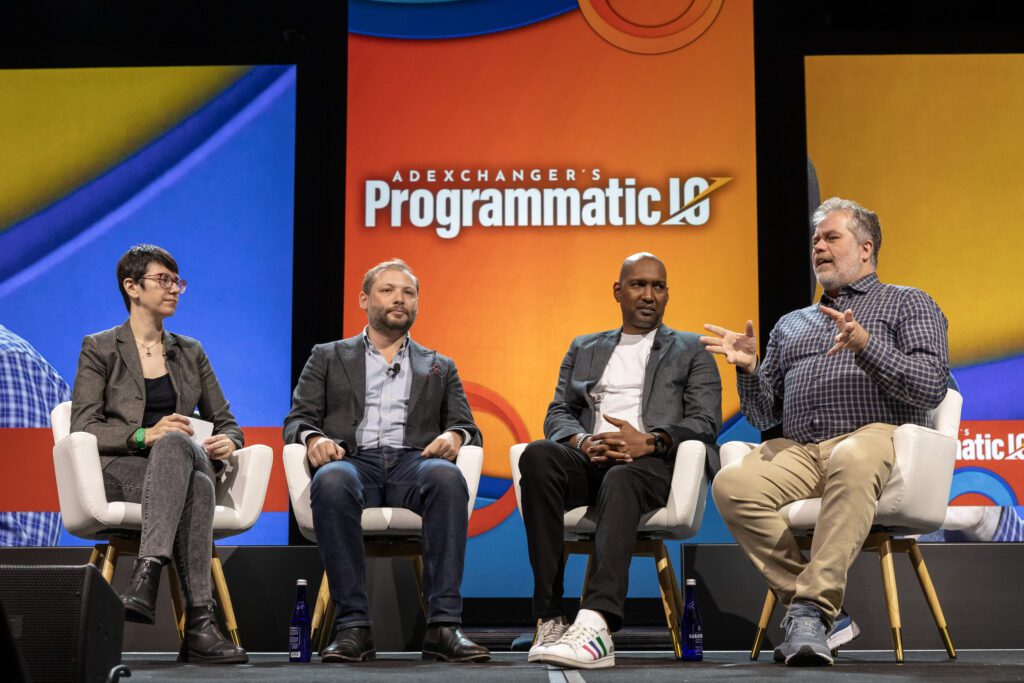
Allison Schiff, Managing Editor at AdExchanger, Ben Hovaness, CMO at OMD, Caval Khan, Chief Growth Officer at Group Black, and Ari Paparo, CEO & Contributor of Marketecture Media discuss the future of the open internet. Photo by Donna Alberico.
What is the open web? The term has gotten lost in the mix, and AdExchanger’s Allison Schiff ensured the panelists revealed the definition from their perspectives early in the session. According to Ari Paparo, CEO & Contributor at Marketecture Media, if you can access a website for free and buy ads freely, it is part of the open web.
Media companies are losing distribution channels and struggle to connect directly with consumers. What are the biggest challenges of the open web? Walled gardens and signal challenges. Can marketers blame consumers for this mess? Not exactly. Marketers helped create the walled gardens by continuing to invest in and work with them.
“The open internet lost the resources to create the content and do a lot of things that it did to keep the communities it had built,” revealed Caval Khan, Chief Growth Officer at Group Black. “That’s why we are all seeing the decline over the last three years. Big publishers are going out of business or restructuring.”
More key points from this session:
- The cloudiness around Chrome’s plan for cookies makes it difficult for publishers to determine the best strategy to combat signal loss.
- Publishers have great tools like WordPress, Beehiiv, and Ghost, along with podcasting, as new solutions for reaching people and monetizing those connections.
- When asked what the future of the open internet was, the panelists responded bright, sleek, diverse, and changing.
TikTok, The Latest to Step In the Search Game
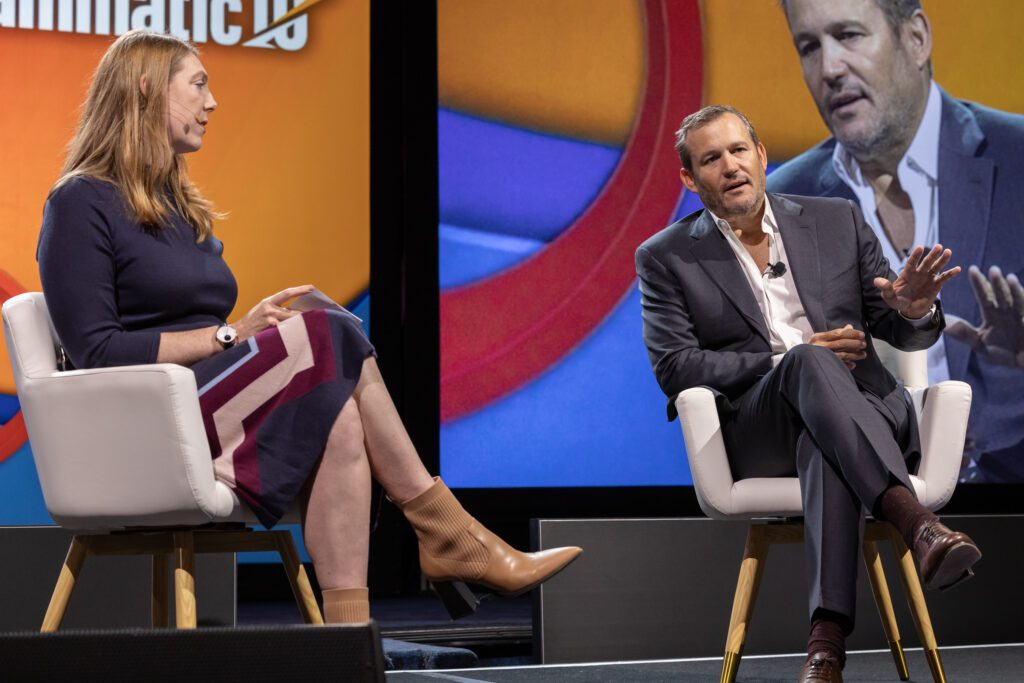
AdExchanger’s Executive Editor Sarah Sluis sits down with Blake Chandlee, President of Global Business Solutions at TikTok, to talk about the platform entering the search business. Photo by Donna Alberico.
TikTok is the app beating Google as the number one search engine. With data showing significant search activity on the app, we’re learning that rich, social media-driven search results are key for connecting with consumers and influencing their discovery and purchase intent. It’s no surprise the company is investing in bringing advertising to search.
“There are two key data points that triggered this for us. One is that independent research proves that 55% of people get their search results from social media and video,” said Blake Chandlee, President of Global Business Solutions at TikTok. “It was just a very good box of rich examples. An example might be if you’re planning to travel to Singapore when you visit a traditional search engine, you’d find links to guide you through that process. On the other hand, you go on to TikTok or some other platforms where you’ll get really rich videos of people like you going through the same decision-making with their experience. It’s a very different experience in the back end of this.”
Ads have been part of TikTok’s monetization model for a while now, but the TikTok shop shook up the game when it came to fruition last year. Live-streaming allows creators to earn money by getting “tipped” from their audience, while the TikTok shop facilitates seamless transitions within the app. TikTok’s investment in logistics and the closed-loop shopping experience allows it to fully capitalize on the commerce generated by creators.
More interesting insights:
- The social media company’s motto: “Don’t make ads, make TikTok’s” works.
- TikTok caters to its users’ diverse interests, allowing brands to connect with highly engaged audiences.
- Ensuring that ads are native is key; don’t oversaturate because ad fatigue can be real.
- TikTok stands out because it is independent and doesn’t rely on partnerships or external links for e-commerce.
Why The Trade Desk is Winning According to Wall Street
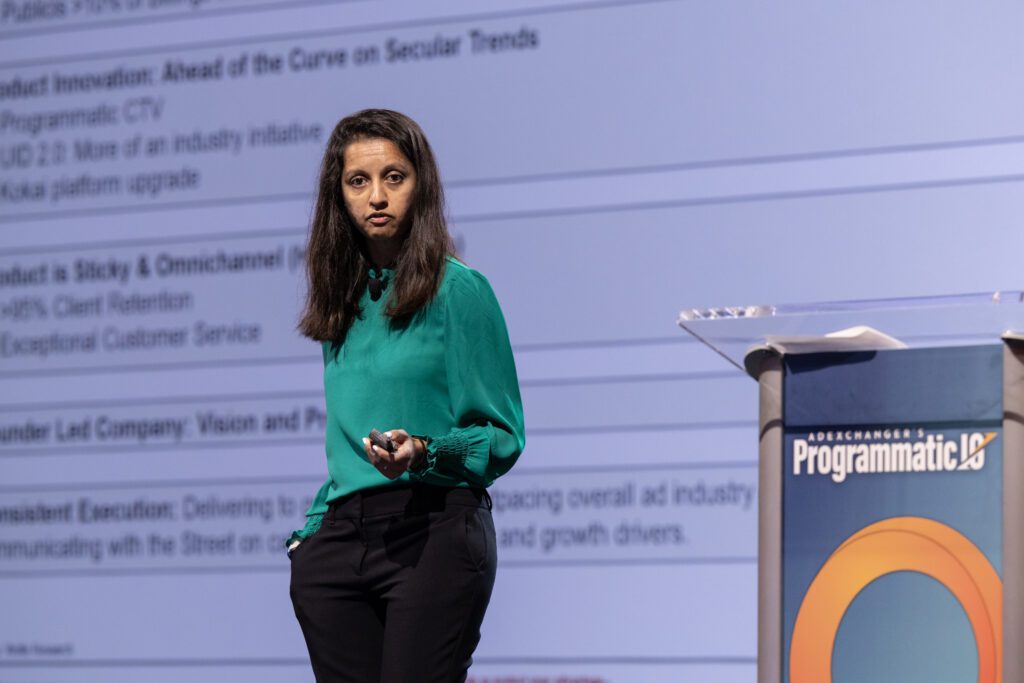
Shweta Khajuria, Managing Director of Wolfe Research shared her predictions for the industry from an investor’s perspective. Photo by Donna Alberico.
With the ongoing regulatory scrutiny of Google and the pending cookie deprecation, scale and first-party data are both emerging as leaders in the industry.
Shweta Khajuria, Managing Director at Wolfe Research, dove deeply into The Trade Desk’s success. Partnering with agencies leads to higher retention rates. Product innovations like CTV and UID2 have kept The Trade Desk at the top of the industry. Also, their independence and omnichannel approach allow them to maintain objectivity and avoid conflicts of interest.
“Trade Desk saw the potential of bidded programmatic and connected TV before most others in the industry,” said Shweta. “As a result, with the head start that they saw, they saw a step change in their growth rates and trajectory.”
Shweta also predicts that Google will spin off one of its ad tech businesses, which could level the playing field.
Shweta’s other predictions:
- The Trade Desk’s Open Path and Magnite’s clear line anticipate the convergence of the demand and supply sides.
- Efficiency gains will be necessary, and pricing pressures might arise as DSPs and SSPs merge.
- Larger publishers may develop their yield management systems, leading to supply-side consolidation.
- The demand side might gain an upper hand due to its proximity to ad budgets.
Google on Trial: The Battle for Fairness, Transparency, and the Future
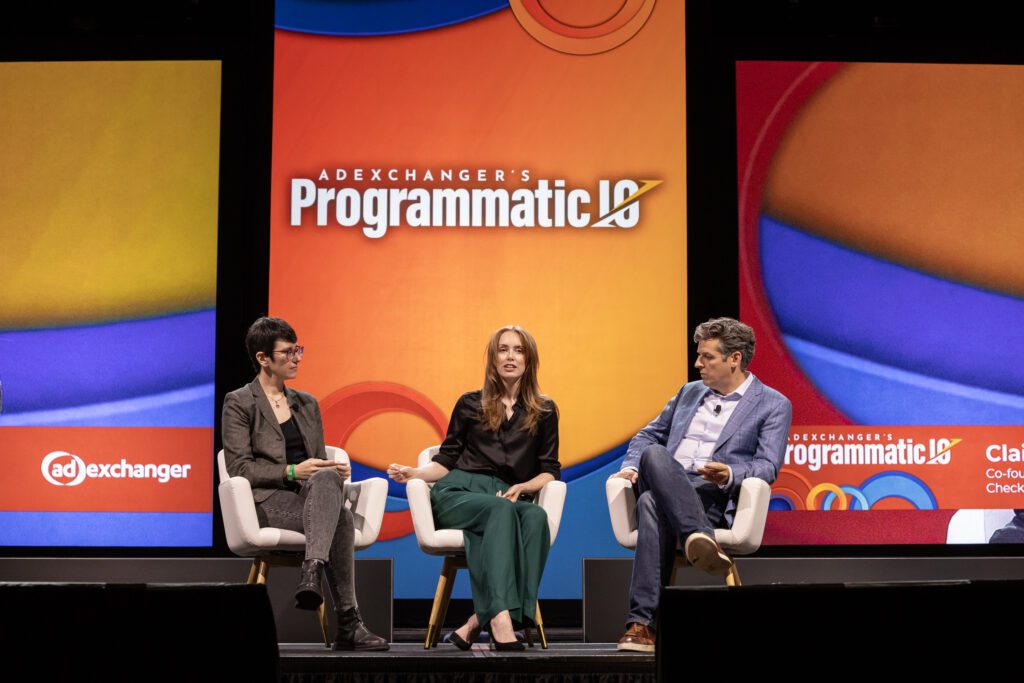
Allison Schiff talked to Claire Atkin, Co-founder & CEO of Check My Ads and Jason Kint CEO of Digital Content Next about the ongoing DOJ vs. Google antitrust trial. Photo by Donna Alberico.
Google’s monopolistic practices have heavily hindered the publishing industry, and we are all standing on our toes, waiting to see the outcome of this decision. Jason Kint, CEO of Digital Content Next, explained how Google is extracting value that should go to newsrooms and entertainment companies.
Jason talked about “dynamic revenue sharing,’ where Google manipulates bid prices to maintain its margins, often behind publishers’ backs. With a press box seat at the trial in Virginia, he says Google’s defense strategy is to confuse the market and redefine it to include more competition, like TikTok or TV. Isn’t this what we’ve all been thinking? Isn’t this a weak defense?
It was great seeing Claire Atkin again doing her best: exposing the real. According to Claire, Google plays a huge role in monetizing misinformation and lacking transparency. Smaller businesses suffer since they don’t receive funds or adequate support from Google when campaign issues arise. Claire argues for log-level data transparency and know-your-customer laws to ensure fair practices.
Other important highlights:
- Judge Leonie Brinkema is skeptical of Google due to evidence purging, which impacts the credibility of Google’s witnesses.
- The trial is part of a broader antitrust movement against major tech companies, and breaking them up could lead to more opportunities and fairness in the industry.
- Both speakers hope to see a future where advertisers can better track and verify their ad placements, leading to more accountability and fewer fraudulent practices.
FAST is Moving Fast
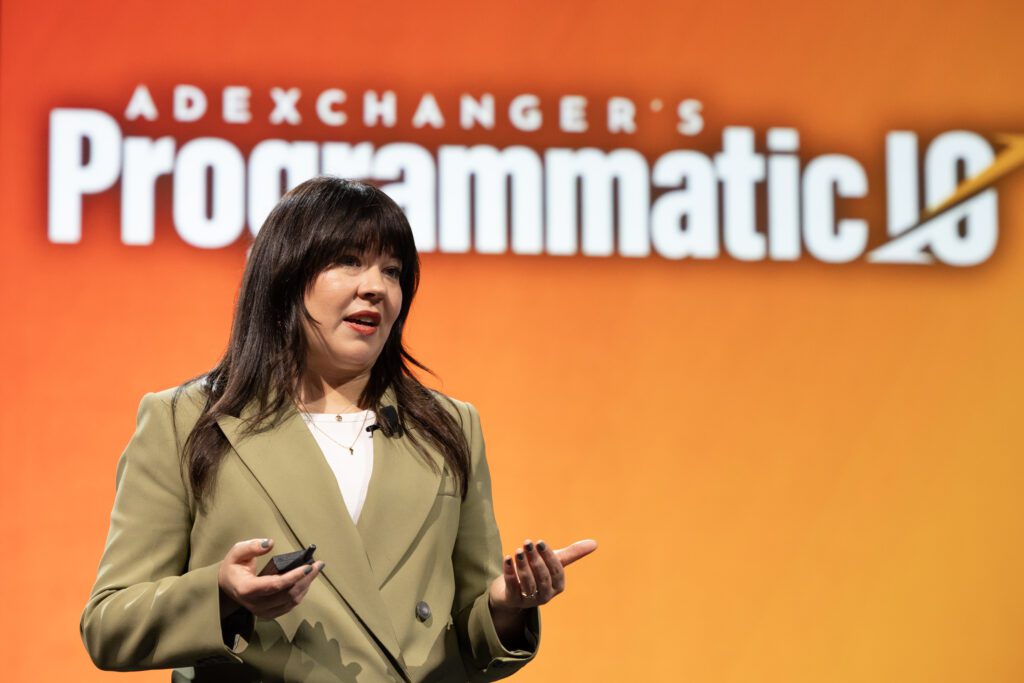
Katie Barrett, Head of Strategic Sales at LG Ads Solutions talks the future of FAST at AdExchanger’s Programmatic IO Day 1. Photo by Donna Alberico.
Several factors are contributing to the rise of FAST, such as subscription fatigue and evolving audience behavior. On a daily basis, consumers are shifting their mindset from avoiding ads to accepting them if they come with free content.
“We see that 53% of our consumers are spending at least 2 hours a day in FAST, and the average time of the session is 73 minutes,” said Katie Barrett, Head of Strategic Sales at LG Ad Solutions. “Eighty-seven percent of FAST users have free streaming channels they watch regularly. This shows high levels of habitual viewing. Eighty-one percent believe that FAST streaming channels offer high-quality content. This is important because this perception of fast being low quality is being challenged here.”
Contrary to popular belief that FAST viewers are less engaged or loyal, Katie argues they are developing strong followings due to curated content. The stereotype that FAST viewers are solely budget-conscious is false, as the data shows a diverse and affluent audience.
Other Factors of FAST:
- The median income of FAST users is $85,000, with an average of $110,000, and 43% earning over $100,000 annually.
- FAST is popular among family units, with a high percentage of users owning homes, being married, and having children, underlining its family-friendly nature.
- FAST is a valuable platform for brands aiming to reach key demographics.
On the Horizon: A New Era for Publishers and Marketers
Publishers and marketers are standing on the brink of significant change. With walled gardens tightening their grip and signal loss challenging traditional methods, publishers are redefining their approach to audience engagement, while marketers are pushing for more autonomy in how they reach and connect with consumers.
From publishers exploring innovative content distribution methods to marketers reclaiming creative control, the next chapter is about pushing beyond the familiar and embracing new opportunities.
The journey doesn’t stop here. Day 2 included more revelations and strategies, so stay tuned for our Programmatic IO Day 2 wrap-up on Monday. We’ll dig deeper into the discussions, highlighting key takeaways and what lies ahead for publishers and marketers in this fast-moving space.